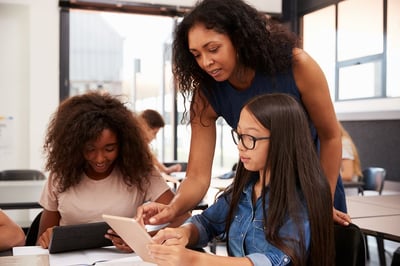Blended learning – the process of seamlessly combining the best aspects of in-person classroom instruction and online instruction – is becoming increasingly popular in higher education settings. Providing greater flexibility for both students and teachers, a hybrid learning model enables non-traditional students to pursue higher education and gives teachers the ability to engage students in a more enriching classroom experience. Here are some strategies that newly qualified teachers can use to incorporate blended learning technology into their syllabuses.
- Pre-record lectures for your flipped classroom
A flipped classroom reverses the traditional lesson structure in which students listen to a lecture in class and then complete exercises on the content at home. Instead, students study the course material outside class first, through readings, video lectures, or research assignments, and then discuss what they learned or complete additional activities to enhance their understanding in the classroom. You can use a lecture capture tool such as Panopto to record live lectures, demonstrations, or supplemental materials for the multimedia online portion of the class.
- Facilitate student collaboration with a digital notice board
Collaborative learning is a great way for students to work peer-to-peer or in larger groups to develop higher-level thinking, oral communication skills, and leadership techniques. There are several helpful tools that teachers can use to encourage collaborative learning in a blended environment, including Padlet – an online tool that enables you to create a virtual ‘notice board’ on which users can post text, photos, video, sound, or links. With the ability to moderate posts and control who can view the padlet, the app is an ideal collaborative learning tool for teachers in a blended classroom.

- Integrate social media into your classroom
In the real world, social media plays a huge role in everyday life – with most students already familiar with the various platforms, incorporating social media into the classroom provides a familiar experience they can connect to and enhances collaborative learning activities. Skype, Twitter, a WordPress blog, closed Facebook group, or class Wiki can provide valuable knowledge sharing opportunities and provoke engaging online discussions.
- Use a course management system
Blended learning can be easier to implement with a learning management platform that enhances the classroom experience. Edmodo is a social learning resource that enables teachers to create groups, assign homework, schedule quizzes, and facilitate student collaboration outside of the classroom. Moodle is an open source platform that lets teachers and administrators build their own curriculum and integrate external collaborative tools such as forums, wikis, chats, and blogs.
- Enhance project-based learning with real-world challenges
Motivating students to study can be challenging with traditional textbook learning, but digital project-based learning can help them see the bigger picture. Non-profit organisation Educurious links students with a network of professionals who collaborate with them on course projects, give concrete feedback, and help them explore future career possibilities, increasing motivation and reducing drop out rates.
Interested in a teaching career in Higher Education? Falmouth University’s Flexible Learning PGCHE programme focuses on the growing importance of blended learning, enabling graduates to develop an informed and critically reflective teaching practice within a fast-changing sector. Visit our course page for more information.
Discover more:
Why an online masters can give your creativity an edge
.webp)



